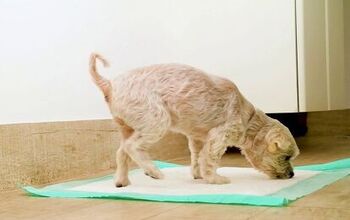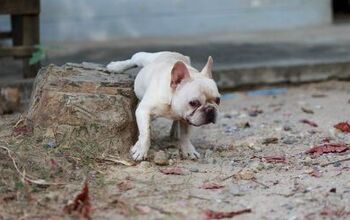Why Dog Pee Kills Grass (and What You Can Do About It)

You can always tell which families in your neighborhood own dogs because of the telltale yellow spots in their yard. Even if you don’t particularly care about having a perfectly manicured lawn, you probably don’t like the idea of it being covered in yellow patches. But why exactly does dog urine damage grass and what can you do about it? Keep reading to learn more.
Related: TaoTronics UV Blacklight Solves the Case of the Invisible Dog Pee Puddle
Why Does Dog Urine Damage Grass?
Your grass doesn’t immediately turn yellow as soon as your dog pees on it – the change in color takes time to develop. But what exactly is it that causes the grass to wither and die after your dog does his business? It all comes down to chemistry.
The first thing to consider when it comes to urine-burned grass is the pH of your dog’s urine. Carnivorous animals (like your dog) have naturally acidic urine, usually between 6.0 and 6.5 on the pH scale, while vegetarian animals have more alkaline pH (upwards of 7.0. If your dog’s diet contains too much grain, it could increase his urine pH which is bad news for your lawn.
Related: Why Do Some Dogs Pee While Doing Handstands?
Another reason your dog’s urine might burn your grass is related to the nitrogen content. Nitrogen is actually a beneficial substance for plants – it acts as a fertilizer – but you can have too much of a good thing. If your dog’s urine is too concentrated with nitrogen, it may damage your lawn. The protein content of your dog’s diet is closely related to the nitrogen concentration in his urine. Your dog needs a protein-rich diet but excess protein is may be broken down by the body in a process that creates extra nitrogen that might end up in your lawn.
How to Prevent Urine Burn in Your Lawn
Now that you have a better understanding of what causes your dog’s urine to turn your grass brown, you may be wondering how to prevent it. Here are some simple tips to try:
- After your dog pees, saturate the area with water – this is most beneficial if you have a female dog since they tend to void their entire bladder in one area.
- Take a closer look at your dog’s food to make sure that the protein in it comes from high-quality, easily digestible sources to ensure less nitrogen waste in your dog’s urine.
- Make sure your dog has access to fresh water at all times – if he drinks more water it will dilute the nitrogen in his urine and reduce urine burn.
- Set aside a specific area of your yard where you train your dog to do his business – this will keep your lawn from becoming covered in brown patches.
Before you take steps to prevent your dog from peeing on the lawn, take a moment to ensure that it really is your dog who is to blame. There are several lawn diseases that can cause brown patches and other changes to the grass, so keep an eye on where your dog urinates for a few days then take a closer look at the grass to be sure it’s him!

Kate Barrington is the loving owner of two cats (Bagel and Munchkin) and a noisy herd of guinea pigs. Having grown up with golden retrievers, Kate has a great deal of experience with dogs but labels herself a lover of all pets. Having received a Bachelor's degree in English, Kate has combined her love for pets and her passion for writing to create her own freelance writing business, specializing in the pet niche.
More by Kate Barrington






















